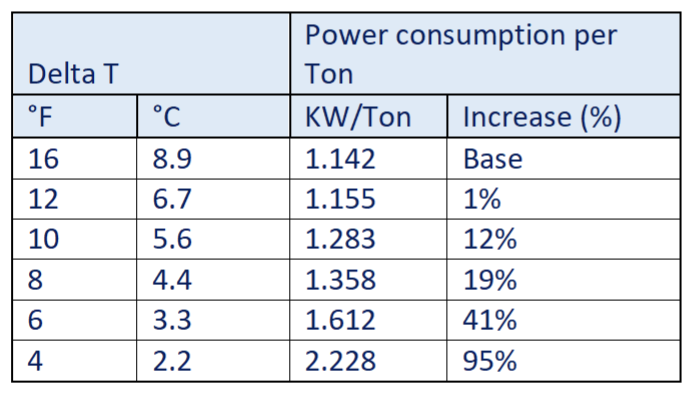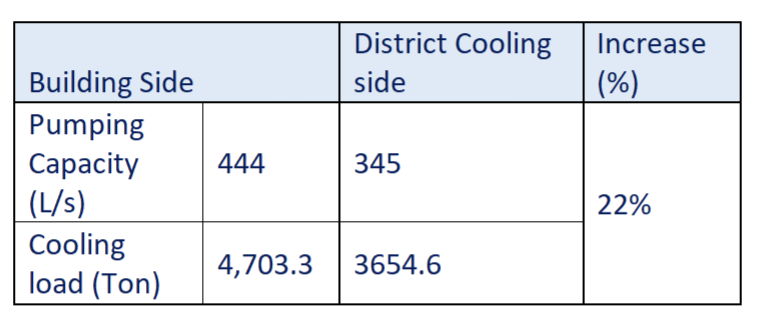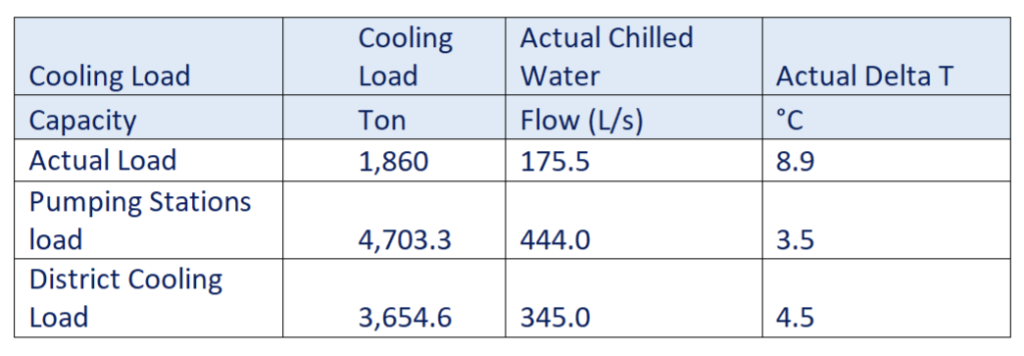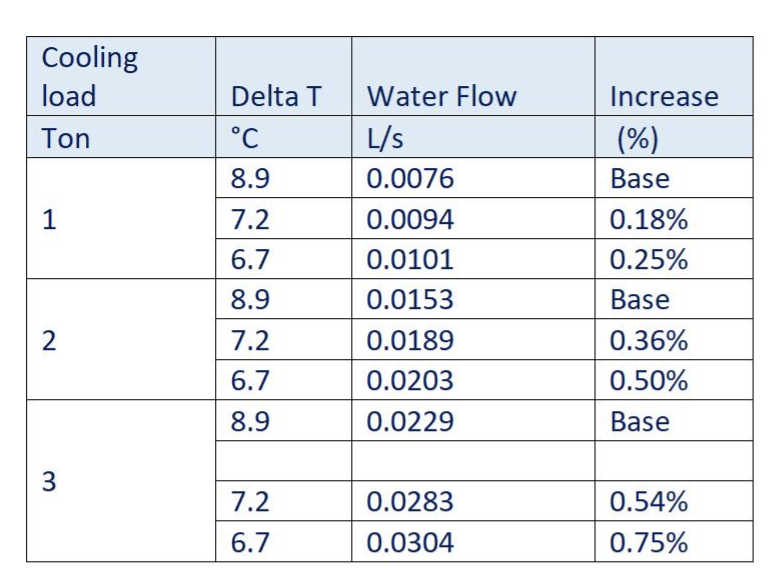Roadmap to a Low Delta T-free world
Improving chilled water Delta T, which is the temperature difference of chilled water supply and return, will not only improve the power consumption of the building but also will impact the central distribution system on the supplier’s side of a District Cooling scheme.
Low Delta T Syndrome results from the inefficient use of chilled water in buildings and plants, leading to a lower return chilled water temperature to the chiller’s side.
As shown in Table 1, Low Delta T Syndrome will lead to a significant increase in power consumption (kW/Ton) through the District Cooling plant. When Delta T is 16 degrees F (8.9 degrees C), the total power consumption will be 1.142 kW/Ton, compared to 1.358 kW/Ton for Delta T of 8 degrees F (4.44 degrees C).

Case Study
To understand the root causes of the low delta T issue at the building side, the chilled water system was challenged continuously for a period of a month. The inspections included site visits and monitoring the BMS.
The findings were impressive and led to a set of clear reasons behind the Low Delta T problem, as follows:
1.1. Design mistakes
1.1.1. Building load versus District Cooling load
This is one of the most valuable players of the Low Delta T game, as controlling the District Cooling chilled water side needs to follow the building-side requirements.
A deep understanding of the cooling load calculations is unavoidable. And the sustained negligence of the training needed for mechanical engineers would lead to extra safety factors that would impact the building-side Delta T.
A detailed study of the drawings and comparing them with the actual capacities of the chillers revealed that the designer was oversizing the cooling load…

As a remedial measure, future loads need to be considered very carefully, indeed. The developer has a very serious role to play, which needs to be considered while specifying for future developments towards the objective of enhancing the running performance of buildings.


1.2. Actual needed cooling load
Based on multiple visits made to the site and the daily and hourly readings of the BTU meter, the peak cooling load recorded was 1,860 tons, compared to 4,703 tons, as per the building-side pumping stations and 3,654 tons, as per the District Cooling supplier.
Table 3 describes the huge impact of wrongly calculated cooling load on the actual chilled water Delta T. Considering that the peak actual load is around 1,860 tons, with a total water flow of 175.5 L/s, the actual delta will be 3.5 on the building side and 4.5 on the District Cooling side.

1.2.1. Wrong coils selection
Again, designers have a critically important role to avoid the Low Delta T Syndrome. One of the fatal mistakes causing the Low Delta T problem in buildings is related to the selection of the FCUs cooling coil delta T.
Designers and contractors should follow the exact same Delta T provided by suppliers. Although such mistakes are not expected, this is what my team and I faced while trouble-shooting the problem.
Figure 3 describes the root cause of the problem, selecting the coils based on Delta T 7.2 degrees C instead of 8.9 degrees C, which would have a direct impact on the needed chilled water flow for each unit.

As shown in Table 3, lowering the selected Delta T would lead to a clear increase in the water flow demand needed by each unit. The table describes the increase of the chilled water flow needed by each unit serving each space in the building. Selecting coil served by 7.2 degrees C instead of 8.9 degrees C would lead to a 25% increase in power consumption for each cooling ton.

1.2.2. Building de-coupler mixing
Installing de-couplers for future installations is one of the biggest mistakes that designers and contractors could do. With such a large chilled water return, controlling the Low Delta T would be impossible.
Such a point can be avoided only during the design and construction stages, as reconnecting such huge pipes would be impossible during the operational phase of the project. Any attempts at doing so would lead to many abortive works that would affect the operations of the building.
As shown in Figure 4, it would be near impossible to recover from such design mistakes and would lead to a huge Low Delta T.

1.3. Operations
Operators should play a very important role towards the objective of avoiding the Low Delta T Syndrome. Indeed, once the construction has been completed, it would be the operator’s responsibility to control the Delta T.
Operators should have their preventive and regular maintenance and inspections processes in place to avoid issues that could impact Delta T.
1.3.1. Dirty cooling coils
Dirty cooling coils not only affect the cooling capacity and air quality inside the building but also affect the demand of the chilled water flow.
1.3.2. BMS control and monitoring system
BMS has an important role to play in controlling the chilled water system and in avoiding the Low Delta T Syndrome. The BMS Operation and Maintenance (O&M) manual should describe all the factors that may affect the performance of the system, flows, temperatures and the pressure differential sensors set points.
As per BMS sequence of operations, when the ambient temperature is 12 degrees C, the supply chilled water temperature is set to be 12.5 degrees C. Such very high and clearly not acceptable set point would definitely lead to a Low Delta problem.

Also, the bypass valve between the supply and return will open if the temperature of the return chilled water is lower than 14 degrees C.
As a result, in winter and during off-peak time, the supply chilled water would be around 12.5 degrees C, while the return would be 14 degrees C, with total Delta T of 1.5 degrees C.
Conclusion
Controlling Low Delta T while operating a building is not an easy task, especially when the cause of the problem is related to design and construction issues. The cost of replacing coils in our case study was around AED 2 million, in addition to any other losses, especially if the case is related to hotels, restaurants and hospitals.
On the other side, the consultants and contractors should consider the needed plans to increase the knowledge of young engineers, who do the cooling load calculations and the selection of the HVAC system equipment.
Operators have a very important role to avoid and decrease the cause of the Low Delta T problem. Continuous attention to the BMS to monitor and control the pumps’ flows and set points must not be neglected.
Preventive maintenance should be in place as part of the Testing & Commissioning and O&M plans. Cleaning the ducts and coils would not only enhance Indoor Air Quality but also avoid turbulent and laminar flows.
District Cooling providers should play a major role in controlling Delta T. A benchmarking for the buildings considering reasonable cooling density based on building type and GFAs should be considered.
Finally, authorities would always have the upper hand when it comes to setting the roles and responsibilities of each party, considering the early stages of design and reaching to the stage of Low Delta T penalties.
The writer is MEP Manager at Blurock Project Management. He may be reached at abdullah@blurock.ae.

